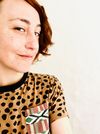Cia Doisacordes. An aerial rope vocabulary for intimacy
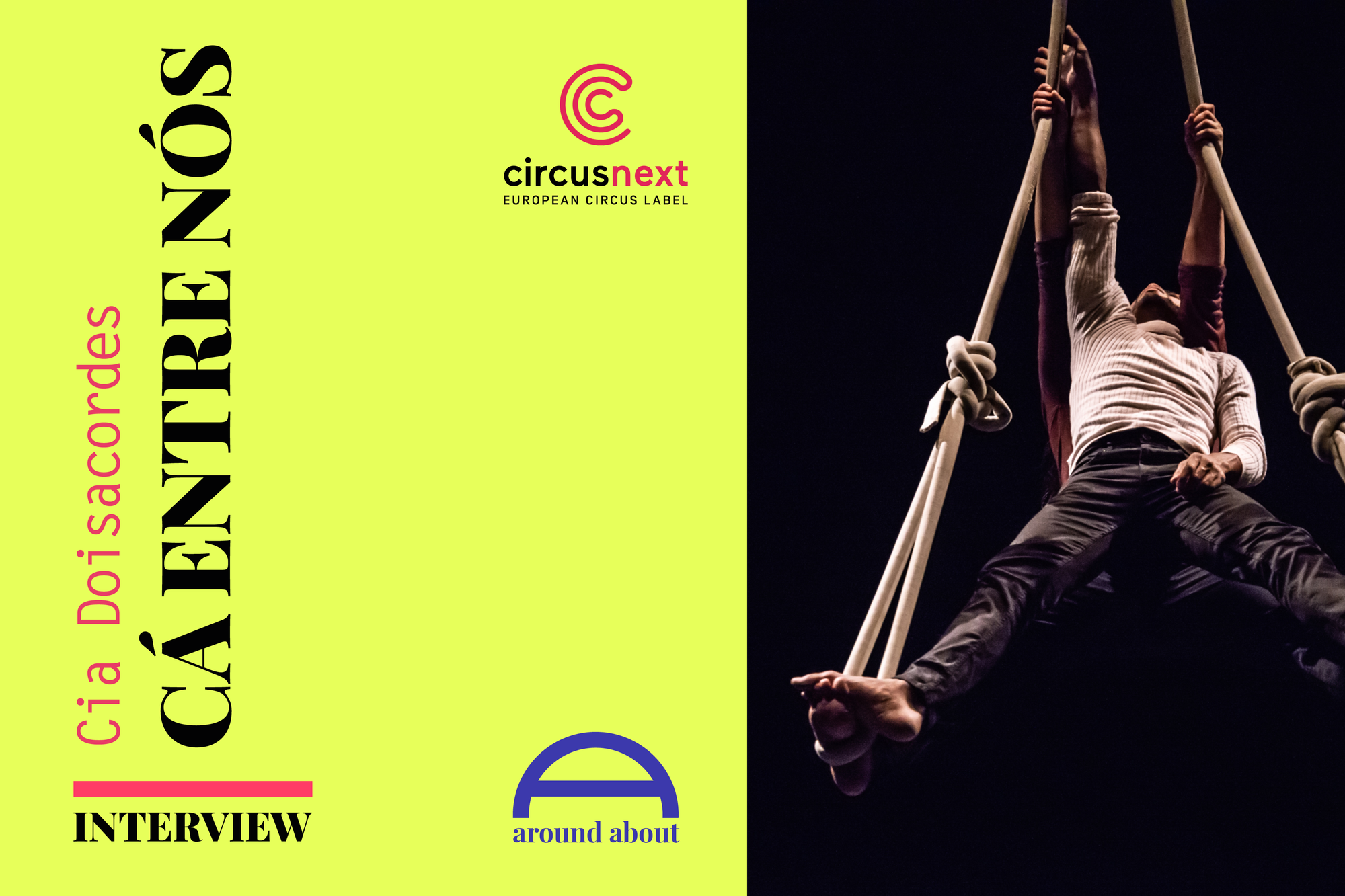
For the circusnext series of interviews, on a sunny Mediterranean afternoon, we meet Thiago Souza and Roberto Willcock of the Catalan Cia Doisacordes online. In reply to our questions, from different places in Barcelona, the two performers from Chile and Brazil tell us more about their story, from their first approach to circus techniques to the decision to become professional circus artists. Engaging with the international circus scene from a non-European point of view, they reveal their sources of inspiration for creating their own technical and artistic vocabulary. We chat about the development of their first show, Cá entre nós (Just between us), the meaning behind the title, and their experience of international touring, a vortex of contexts, attitudes, minds and sights, reflective of their ever-evolving presence on stage.
Cia Doisacordes, Cá entre nós - promo video
Where did your professional journey as a circus artist begin?
Thiago: We met in 2017 when we both attended the ENC (Escola Nacional de Circo) in Brazil, but we started working together two years later. Back then, we didn't have many spaces available to rehearse, but during school, we did several workshops with Roberto Magro that stimulated us creatively. At the end of school, it was natural to be thinking about the future and the different alternatives before us. By sharing our anxieties about the possible paths to take, we discovered the need to question the artistic context we were living in. In the final two weeks of our studies, we started rehearsing together, exploring our ideas. Comparing what we did not like to see in the circus sector around us, we realised we had something in common. We found ideas and got involved in searching for venues that could accommodate our artistic proposal. That's why, before finishing school in Brazil, we applied for a third artistic year at the Flic Circus School in Turin to dedicate ourselves to our artistic creation.
How did you come to want to be a contemporary circus artist?
Roberto: For me, it was a natural choice around 20. I was attending Sports Science at university, and in my second year, I started practising aerial, particularly silks. When I finished my academic studies, I dedicated myself to circus, thus beginning my journey through different countries such as Argentina, Brazil and then Italy. My professional life has been outside Chile for more than ten years now! Considering all of this, today we call ourselves a Spanish company made up of a Chilean and a Brazilian living in Barcelona.
Thiago: I started practising circus around 16 in an amateur school in Belo Horizonte. I continued at an amateur level throughout university, and after graduating in advertising, I became more seriously involved in the apparatus until I wanted to become a professional. After that, my training took place in different cities in Brazil and then in Italy.
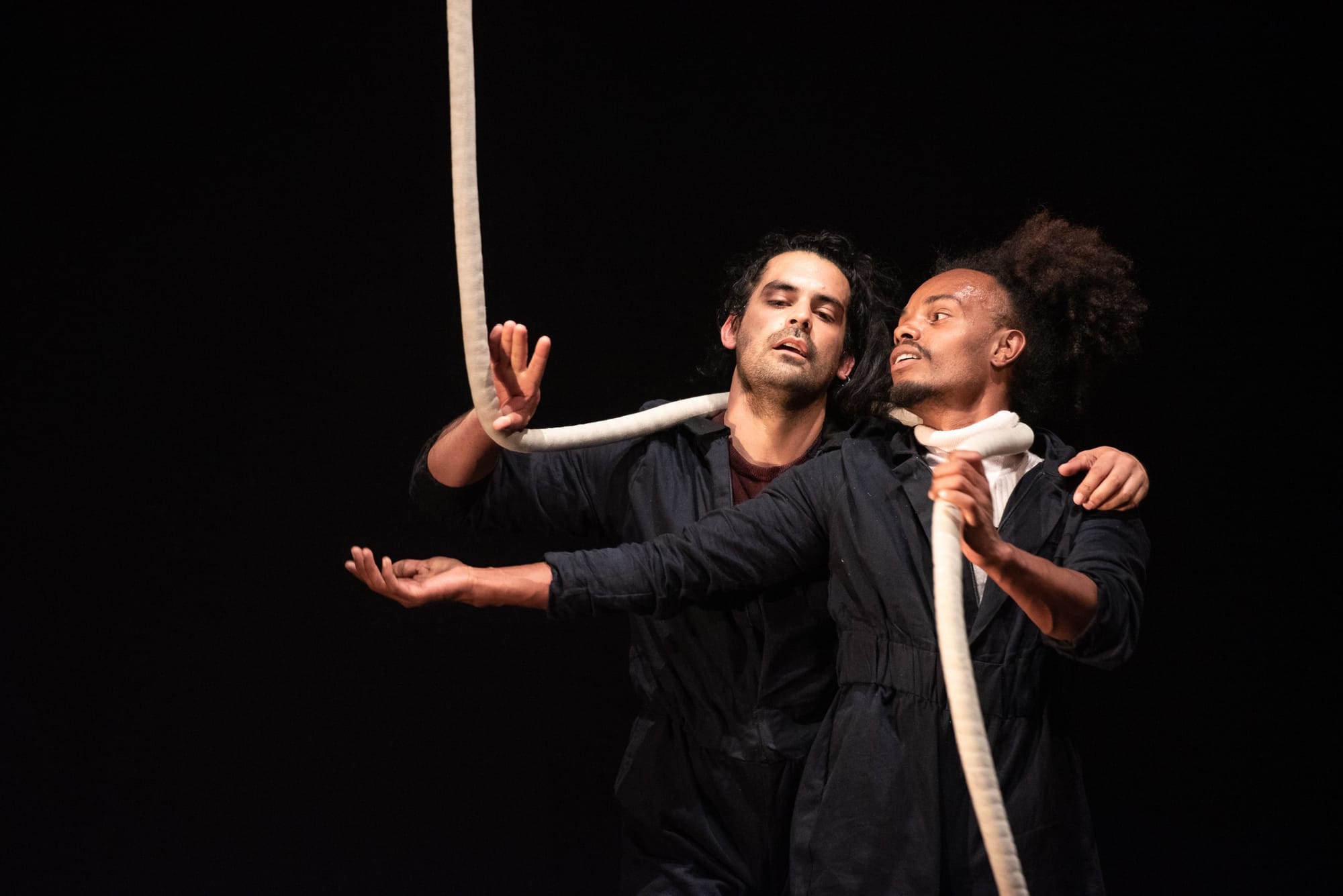
How did you come to specialise in aerial rope?
Roberto: I approached rope by exploring different aerial disciplines. For me, the rope technique is the meeting of something very strong and rigid yet very flexible at the same time. It is the tool I prefer for this very reason. You can manipulate it. It is not as flexible as silks but it is certainly not as rigid as a trapeze. I find manipulating the rope one of the most interesting possibilities. I experiment with it every day and it leads me to creatively find something of my own.
Thiago: In my case, it was my aerial teacher who suggested it. I tried and immediately felt that my body's response was natural. The rope responded to my body in a congenial way. It belonged to me, which is why I immediately felt at ease.
At what point in your creation process did you come across circusnext?
Thiago: The selection of circusnext came at a time when we already had a lot of artistic material to work with. It was a smooth process but one that paradoxically allowed us to deconstruct the 45 minutes or so we already had in favour of some choice scenes, in order to create the 20-minute version to be shown to the jury. The premiere of the show in finished form has not yet taken place. We will make our official debut in April 2024 in Spain at the Mercat de les Flors in Barcelona as part of the Circ d’Ara Mateix.
Roberto: When we were still living in Turin, we attended a lesson with Jean Michel Guy and started talking to him about our idea of a show. We waited to collaborate with him after the end of the selections, and after circusnext, Jean Michel joined the team, helping us to further develop the dramaturgy of the show.
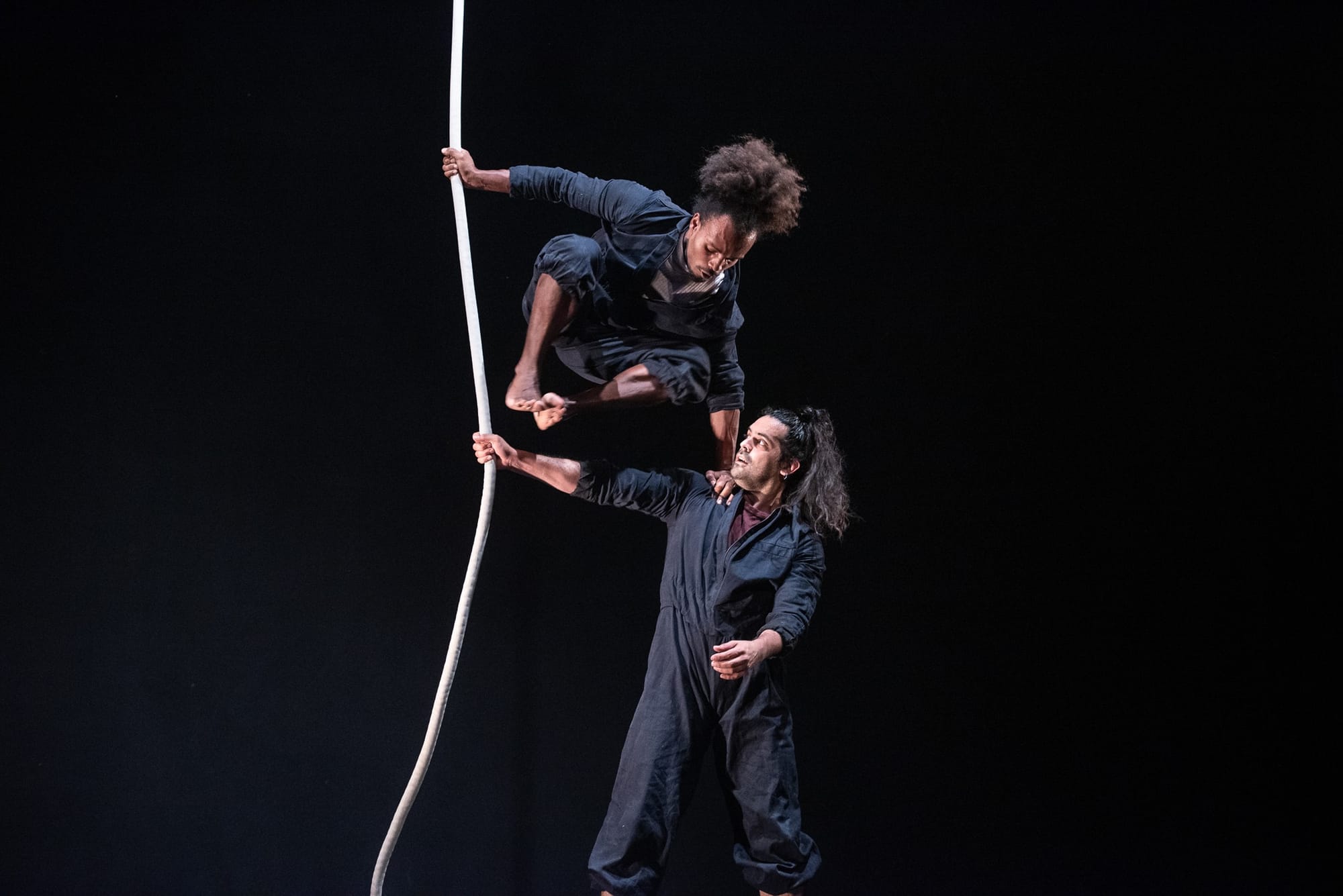
What effect did the selection process of circusnext have on your work?
Thiago: The selection process asks you questions and finding the answers has been very useful in shaping our vision of the show, bringing us to a deeper awareness. Asking ourselves what we like about the circus, for example, a basic question overlooked, allowed us to interrogate ourselves and move towards an aesthetic that really belonged to us. On a practical level, our need to find residences was listened to and we were given a path of linear, structured creation so that we could arrive at the final form of the show.
Roberto: It helped us to research and learn how to express ourselves. We asked ourselves how to portray the interchangeable relationship between base and flyer through the relationship with the rope, leading to the creation of unique images. We formed a shared language. At no time on stage does Thiago hold me as a classical base would. Being a base and a flyer who relate to the rope as a tool, our technique multiplies the creative possibilities at play. In terms of image construction, our vocabulary emphasises the ropes' non-vertical use. At one point we use it almost like a trapeze, at another it recalls the circular movement of a cyr wheel. The element that has been most appreciated within circusnext is definitely the originality in our interpretation of the apparatus, the fact that we have found our own way of making rope together.
How did the dramaturgy of the performance take shape?
Thiago: On a dramaturgical level, we worked in two directions. Starting with the images that we spontaneously found, we combined a technical and artistic approach to putting the materials together. Right from the start, we did not want to outline a definite story, but we were unclear about what we wanted to tell and say. The rope technique is very free, and you find figures. We tried to give shape to powerful images and play with them.
Roberto: Our dramaturgy follows our movements and the figures we find through them. Integrating the logic that comes from movement with technical solutions was the most revealing and liberating part of writing this show. The framework of a poetic circus outlines our intent. We believe in the power of images. We did not want to sketch the psychology of two characters. We are not interested in revealing a precise game between us or referring to a defined dynamic. We explore different possibilities. The audience is invited to glimpse, and why not, even identify with, a symbolic relationship between two individuals.
Thiago: What you see on stage is the relationship between two people who, for some reason, are meant to be together. We play out the various nuances of the relationship, as two people bound together by trust. It is based on a peaceful coexistence, which has its conflicts but allows us to give space to each other's desires, while also respecting our own. We are trying not to find answers, but to keep the evolution of the relationship on stage free, allowing imagination and individual projections and interpretations. In the twenty minutes we presented at circusnext, we chose and put together the most significant scenes. We knew that the scenes were not chronological, but the idea was to choose extracts without any pretence of condensing the whole work. After the presentation in Paris, we were lucky enough to be invited elsewhere and were thus able to make the show grow into its full dramaturgy.
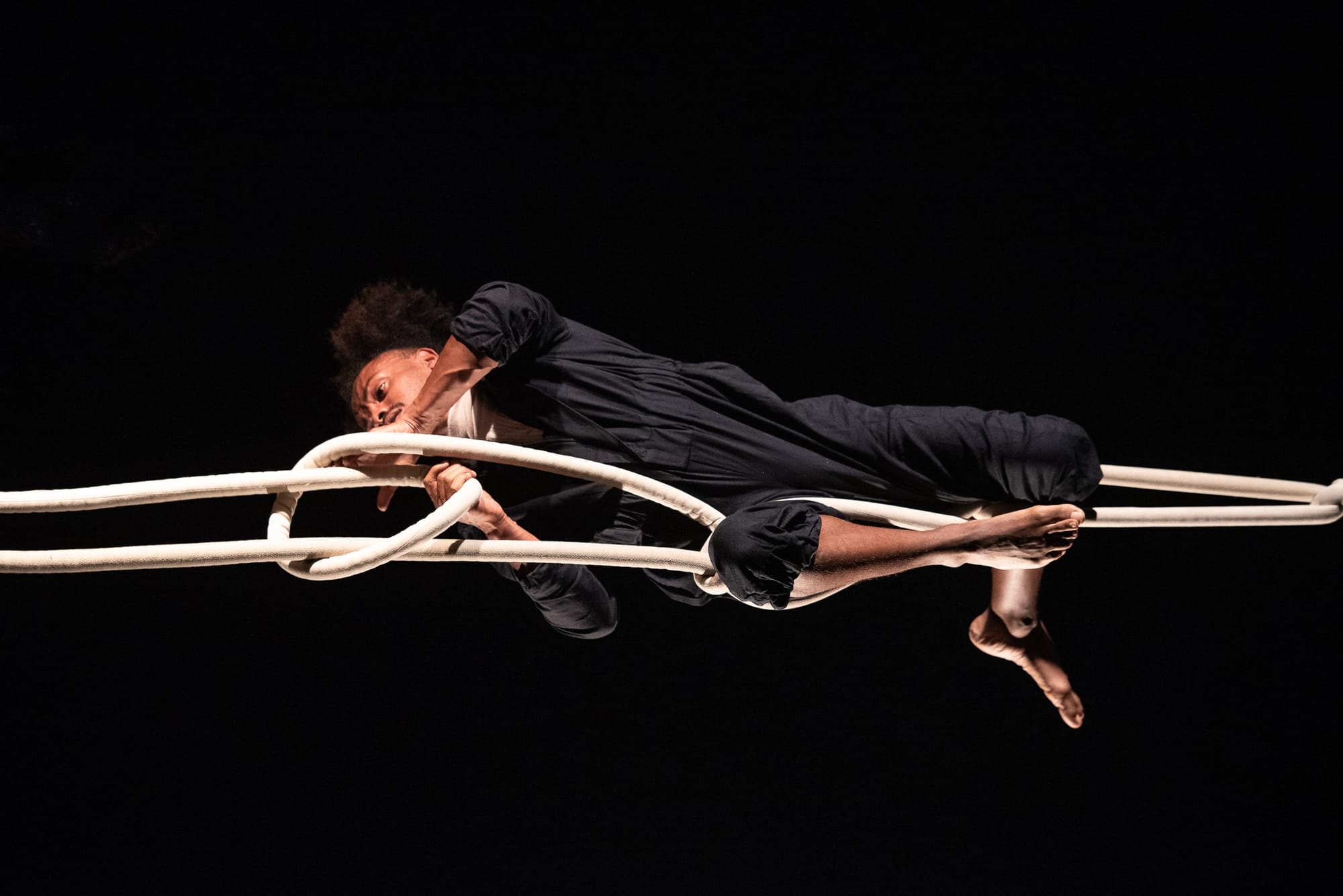
What do you want to convey through your story made of images?
Roberto: The title Cá entre nós is a Brazilian expression that reveals a symbolic dualism. It speaks of the trust in each other in sharing an experience and can be translated as 'Just between us'. It is an expression used before or after an important event and underlines that what has been done or said should only remain between the engagers. However, the word 'nós' still in Portuguese also means 'knots' (which directly references our artistic/technical repertoire). So the title of this performance has a duality of interpretation: cá entre nós: ‘just between us’ and ‘just between knots’. This 'us' also includes the audience, creating a precious intimacy between the spectators and those on stage, a feeling we wanted to convey.
What audience reactions have made an impression on you so far?
Thiago: We are struck by the variety of feedback we get at each performance because everyone sees a different story in our relationship on stage. Cá entre nós is a performance without text but with a powerful vocabulary. What for us is a circus installation of aerial rope, for a Finnish woman was seen as her family tree. Gathering the stories from the spectators after the performance is very moving.
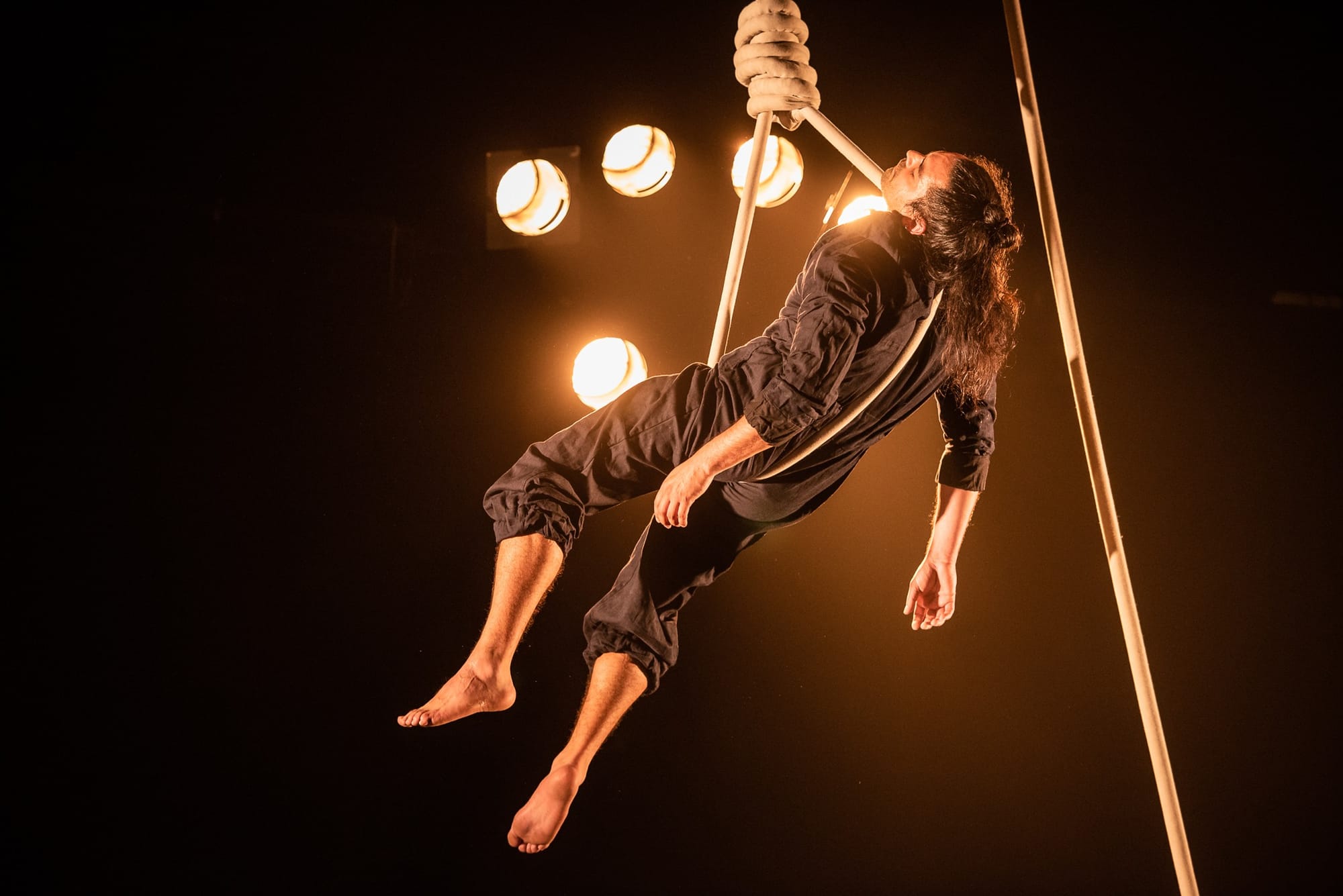
Who are the other collaborators who contributed to the project behind the scenes?
Thiago: In addition to the aforementioned Jean Michel Guy, who followed our writing process at several points, we recently finalised the lighting design with Gabriela Bianchi. She is a lighting designer who also attended a circus school. She is from Chile and we have known each other for ten years and share a similar aesthetic and visual taste. For the music, we worked with Lithuanian musician Jokubas Tulaba, who accompanied us during our residency at Cirko Sapiens last year, and we are now fine-tuning the final music with Catalan composer Adrià Juan. Besides being a friend who does interesting sound research, he was able to bring the extra nuance we were looking for to the show.
Do you have any particular inspirations that have contributed to your development as a creator?
Thiago: For me, a revelatory moment on a creative level was attending one of Jean Michel Guy's show lectures in 2013, during my time at circus school in Brazil. ACORDA! traced the trajectory of aerial rope technique and creativity, from its birth to its contemporary evolution. It featured Breno Gaetano, Sanna Vellava, Edmar Cândido and Eric Vinicius. It was the first time I saw aerial rope in a truly free artistic and creative form. Back then, it wasn't so easy to find, there wasn't yet social media or videos online to learn from.
Roberto: One of the circus companies that I find most expressive and that I consider a reference for me on a creative level is Cie Ièto. Both acrobats, I saw them live and have been inspired by their way of being together on stage ever since. I would also mention Juan Ignacio Tula and Stefan Kinsman in Santa Madera for the same reason.
